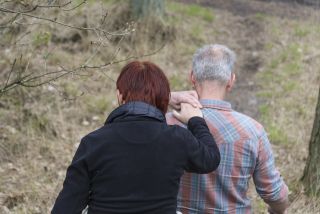Education
Learning From Disability: Personal Version
Personal Perspective: I’ve been temporarily disabled before but never like this.
Posted October 7, 2024 Reviewed by Jessica Schrader
Key points
- People wonder what to ask or say to someone with a disability.
- Knowing what to do—as well as what not do—are equally important.
- We’re “temporarily-abled” and can learn to normalize disability—for ourselves and others.

My toes began scudding under my right foot, not clearing the ground as I walked. I started tripping. I had to forego a lifelong love of running, my right leg pulling strangely toward the ground. Soon, I sported an all-the-time painless, right-legged limp.
I was sure it was worst things: ALS. MS. Parkinson’s. Brain tumor. Stroke. These were what medical providers were thinking too (and sometimes saying out loud) as I visited specialist after specialist to figure out what was wrong. (I wrote about that here.)
Turns out, I have runner’s, or focal, dystonia. An obscure disorder most medical providers—including nearly all sports medicine, orthopedic, and neurological specialists I saw—have never heard of. But it’s a thing. A thing people get from doing repetitive movement (like I did over and over and over again running on the track for years). Musicians get musician’s dystonia, in their fingers. It’s kind of like the twisties that Simone Biles made famous. Like an arrythmia, a jammed heart rhythm. But in dystonia, the neural connection gets jammed between the brain and extremity (in my case, right leg and foot).
There is good—actually super great—news about dystonia. It’s not those debilitating degenerative disorders I worried about. People recover; it takes lots of work and retraining, but neuroplasticity is also a thing, and it works. And there’s more good news: it won’t progress, it’s generally painless, and my leg behaves wonderfully when I swim, dance, do yoga, or anything but walk.
The not-so-great news? I limp, and will, at least for a while. It’s noticeable. People stare. Everyone and their sister seems to want to comment. “You’re limping!” “Oh no, are you OK?” “What’s wrong?”
When an acquaintance pipes up to tell me, “You’re limping!” it takes impulse control to not blurt, “Really? I didn’t notice. I better check that out.” Then they ask what’s wrong and, because dystonia is rare and unknown, it takes time to explain, which I prefer not to do. Then they ask more questions. Ad nauseum.
Here’s what I wish people wouldn’t do.
- Don’t ask. When you see someone with a disability, assume 10 people have asked them about it before you that day. Whether it’s prurient interest, true caring, or because you dislike the person and secretly hope bad things befall them (OK, we’ve all thought it!), don’t ask. Ever had a cast and been asked hundreds of times, “What happened?!” Yeah, like that. Simply no need. Don’t.
- Don’t say, “You seem worse today.” Some days I walk better than others. I’m aware. And it harshes my vibe to hear it looks worse when it actually feels better. I know people say this when they see me walking (the only time I limp). But it still bums me out. We’ve been taught not to say, “You look tired.” It’s like that. Keep assessments to yourself.
- Don’t assume I need help. I walk faster than most people, even with dystonia. I just look wonky doing it. Don’t assume I need you to open a door, walk slowly beside me, or unburden myself about my condition. I can bring it up if I choose, ask you to walk slower if I need, or request anything else. That’s on me.
But please, do the do’s.
- Do mention someone’s disability if you like. We know it’s visible. I’m impressed and grateful when people say, “If you want to talk about it, go ahead.” Because with close friends and family, I do want to talk. About treatment, what I’m learning, how I’m feeling… or how frustrating and irritating stares and questions can become. I'd just like to be the one choosing to discuss it or not.
- Do offer help if you like. Don’t assume help is needed, but let us know you’re available. One tip for dystonia is walking backward. Friends and family know. They sometimes offer to stride forward, arm-in-arm with me, while I walk backward, so I don’t trip on rocks or curbs. Simply offer if you like: “Let me know if you want me to do anything.”
- Do normalize disability. Disabilities, we’re learning, are more the norm than the exception, whether invisible (mental health issues, learning disorders, chronic illness, and so on), or visible, like mine. Ableism is discriminatory in our culture, and we’d do well to realize we are all “temporarily-abled.” Anytime you silently identify your invisible disability (it’s a spectrum, we almost all have them!) with another person’s visible disability (wheelchair, limp, impulsive vocalizing, or what have you), you help destigmatize, making us all “typical” and connected. Because we are.
There’s more great news. Every day I’m grateful I have dystonia and not something more debilitating. My pride has taken appreciated knocks as I’ve learned humility in being stared at, or pitied. I get to practice appreciating others—rather than getting irritated with them—for these lessons. And in our society, where reaching out for help is considered weakness (even though I know and even teach it’s in fact strength), dystonia helps me ask for assistance. It supports my collaborative, connecting, vulnerable, “asking for help” muscles.
It turns out dystonia frequently befalls hard-driven, eager, type-A caregivers (don’t look at me!). It has taught me to slow down, and to be gentler and compassionate with myself—and others. I’m hopeful treatment works and my gait recovers. But if it doesn’t, I’ll still feel lucky. I might not have had the opportunity to learn these lessons any other way. My body is talking to me. And I’m listening.



